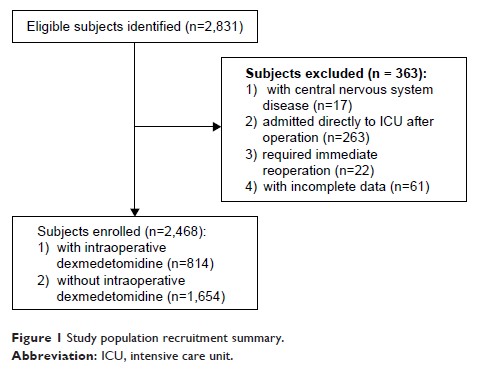9 7 8 1 6
论文已发表
注册即可获取德孚的最新动态
IF 收录期刊
- 3.3 Breast Cancer (Dove Med Press)
- 3.4 Clin Epidemiol
- 2.5 Cancer Manag Res
- 2.9 Infect Drug Resist
- 3.5 Clin Interv Aging
- 4.7 Drug Des Dev Ther
- 2.7 Int J Chronic Obstr
- 6.6 Int J Nanomed
- 2.5 Int J Women's Health
- 2.5 Neuropsych Dis Treat
- 2.7 OncoTargets Ther
- 2.0 Patient Prefer Adher
- 2.3 Ther Clin Risk Manag
- 2.5 J Pain Res
- 2.8 Diabet Metab Synd Ob
- 2.8 Psychol Res Behav Ma
- 3.0 Nat Sci Sleep
- 1.8 Pharmgenomics Pers Med
- 2.7 Risk Manag Healthc Policy
- 4.2 J Inflamm Res
- 2.1 Int J Gen Med
- 4.2 J Hepatocell Carcinoma
- 3.7 J Asthma Allergy
- 1.9 Clin Cosmet Investig Dermatol
- 2.7 J Multidiscip Healthc

手术中右美托咪定输注与肺外科手术后出现躁动减少和恢复情况改善有关:一个回顾性队列研究
Authors Kang X, Tang X, Yu Y, Bao F, Gan S, Zheng W, Zhang J, Zhu S
Received 19 November 2018
Accepted for publication 10 February 2019
Published 12 March 2019 Volume 2019:13 Pages 871—879
DOI https://doi.org/10.2147/DDDT.S195221
Checked for plagiarism Yes
Review by Single-blind
Peer reviewers approved by Dr Andrew Yee
Peer reviewer comments 3
Editor who approved publication: Dr Qiongyu Guo
Purpose: This
retrospective cohort study aimed to investigate the association between
intraoperative dexmedetomidine infusion and emergence agitation (EA), and
recovery profiles after lung surgery in adult patients. It was hypothesized
that dexmedetomidine was associated with reduced EA and improved recovery
profiles.
Patients and methods: A
single-center chart review was conducted on elective lung surgeries in adults
between January and December 2016. The primary outcome was the incidence of EA
in postanesthesia care units (PACUs). The secondary outcomes included rescue
analgesia, shivering, time to extubation, residual sedation, postoperative
pulmonary events, duration of PACU stay, length of hospital stay, and
intraoperative hemodynamic changes. Univariate and multivariate regression
analyses were used to analyze data.
Results: Among
2,468 patients, 814 received an intraoperative dexmedetomidine infusion.
Intraoperative dexmedetomidine infusion was associated with a lower incidence
of EA (10.9% vs 15.0%; adjusted OR, 0.67; 95% CI, 0.51–0.87; P =0.003), rescue
analgesia (7.6% vs 12.2%; adjusted OR, 0.63; 95% CI, 0.47–0.86; P =0.003), shivering
(4.2% vs 6.6%; adjusted OR, 0.58; 95% CI, 0.38–0.88; P =0.010), and
intraoperative bradycardia (18.6% vs 12.6%; adjusted OR, 1.51; 95% CI,
1.19–1.92; P =0.001).
No differences were observed in residual sedation, duration of PACU stay,
postoperative pulmonary events, and length of hospital stay between the groups.
Conclusion: This
retrospective study suggested that intraoperative dexmedetomidine infusion was
associated with a lower incidence of EA, rescue analgesia, and shivering in
adults after lung surgery. Intraoperative bradycardia was the main side effect.
Keywords: dexmedetomidine,
emergence agitation, intraoperative administration, lung surgery, recovery
profiles
